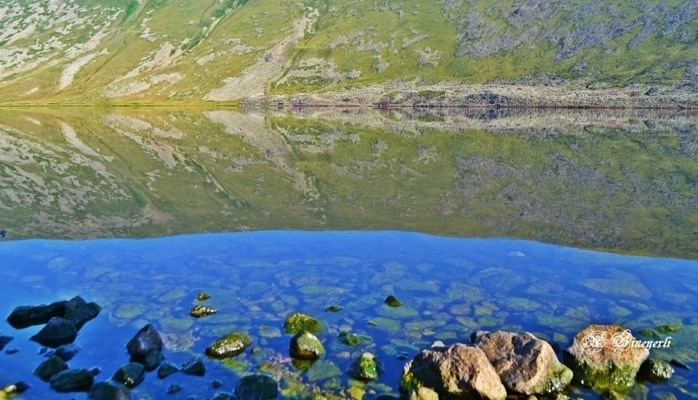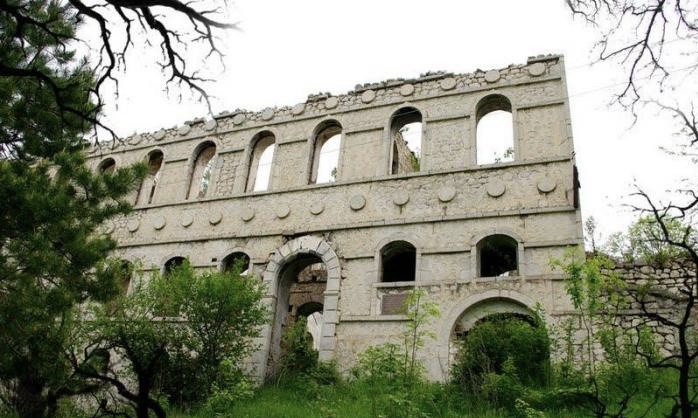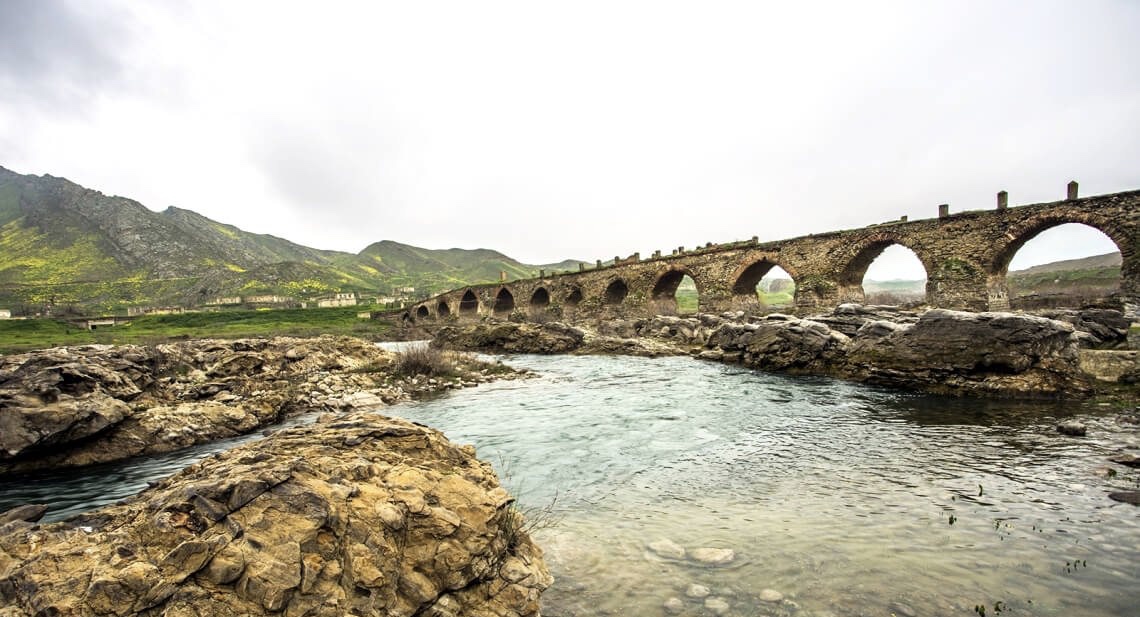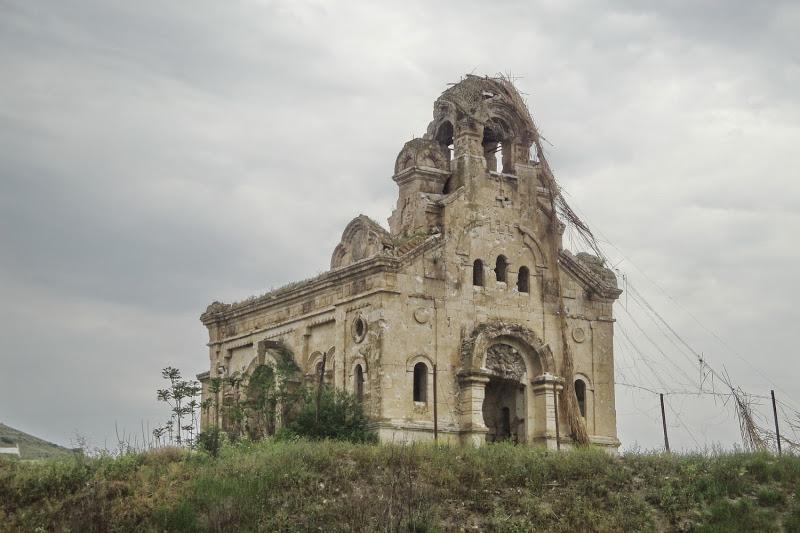






of







of







of





















“The 19th century Aghdam Juma Mosque is perhaps the only structure that has withstood the years of neglect since the occupation. However, it bears scars of the violent past, with a large hole in one of its nine domes and a bullet-ridden mihrab [altar]”.[1] This is what the journalists wrote about the Aghdam Juma Mosque during their visit to Aghdam after its liberation from the Armenian occupation in accordance with the trilateral ceasefire agreement between Azerbaijan, Armenia, and Russia.
Aghdam Juma Mosque is one of the Masterpieces of architect Karbalayi Safikhan Garabaghi and one of the valuable historical and religious monuments of Karabakh. It was built between 1868-1870. It is location is M.F. Akhundov Street of Aghdam city.
The core of the prayer hall of the Aghdam Juma Mosque project comprises a traditional square shape bearing four pillars in the middle. Three rows of deep niches carved in the east and west sides of the square widened the space of the hall and gave it a rectangular shape. There is a high sanctuary niche in the middle of the south wall of the prayer hall. Elegant sanctuary niche bears an inscription of the name of the master of architectural decor (late Karbalayi Naggash Tabrizi’s son – master Mahammad Naggash Tabrizi) and repair date (1331 Hegira calendar, 1913 AD).[2]
The Mosque has a four columned square plan and is adorned with two beautiful minarets, which are traditionally part of medieval Azerbaijan architecture. While the building itself is made of stone, the minarets rising from the corners of the facade are made of brick.[3] Proceeding with the tradition of Juma mosques with two minarets widespread in medieval Azerbaijani architecture, the architect Karbalayi Safikhan Garabaghi created the original type of mosque – Aghdam Juma Mosque in accordance with the call of his times, also architecture and construction experience of Karabakh.[4] The mosque was built in the typical style for mosques in the Karabakh region, which included the division of stone columns on the two-story gallery and the use of domed ceilings. Other mosques that resemble with Aghdam Juma Mosque in style include the Barda Mosque, the Yukhari Govhar Agha Mosque in Shusha, a mosque in Fuzuli, and one in the village of Goradiz.
However, like other buildings and historical monuments in Aghdam city, Juma Mosque was also plundered and demolished during the occupation of Aghdam by the Armenian Armed Forces in July 1993. As it is stated before, the Mosque is the only building left standing in Aghdam city as the entire town was destroyed by Armenians as the result of the First Nagorno-Karabakh War of 1991-1994. The mosque has been vandalized, used as a cowshed and the roof and attic of the mosque have been pulled down, while windows, doors, interior finish, and the marble floor have been destroyed.[5] Regarding this, Andrei Galafyev, a photographer who visited the mosque in 2007, reported that “The floor in the mosque is entirely dirtied with the manure of cattle, which wanders on the ruins of Agdam in the daytime”. Furthermore, Associated Press writes in this regard that, “Under Armenian control, the mosque was used for years as a stable for cattle and swine, a defilement that deeply angered Azerbaijanis”.[6] Thus, the current state of the mosque once again demonstrates the violation of the “1954 Hague Convention for the Protection of Cultural Property in the Event of Armed Conflict” by the Republic of Armenia.
[1] Cetinkaya, Behlul and Rehimov, Ruslan, “Azerbaijan: Residents recall lost glory of Aghdam city”, AA, 28 November 2020. https://www.aa.com.tr/en/azerbaijan-front-line/azerbaijan-residents-recall-lost-glory-of-aghdam-city/2059164.
[2] “Aghdam Region”, Armenian Vandalism: Azerbaijani Monuments in Captivity. https://www.armenianvandalism.az/en_aghdam.html.
[3] “Aghdam Juma Mosque”, Ministry of Culture of the Republic of Azerbaijan, 05 October 2020. http://mct.gov.az/en/common-news/13238.
[4] “Aghdam Region”, Armenian Vandalism: Azerbaijani Monuments in Captivity. https://www.armenianvandalism.az/en_aghdam.html.
[5] Carlotta Gall and Anton Troianovski, “After Nagorno-Karabakh War, Trauma, Tragedy and Devastation”, The New York Times, 12 December 2020. https://www.nytimes.com/2020/12/11/world/europe/nagorno-karabakh-armenia-azerbaijan.html.
[6] Manenkov, Kostya, “Azerbaijani leader hails handover of region ceded by Armenia”, AP, 20 November 2020. https://apnews.com/article/azerbaijan-handover-region-armenia-2d0d88c012fdd16732cecd35d134cabf.

Qaragol Interrepublics State Reserve was set up with the decision of the Council of Ministers dated November17, 1987. Garagol State …

The idea of establishing Aghdam Bread Museum, which is considered to be the second in the world after the Zurich …

The Khurshudbanu Natavan’s House is a historical and architectural monument of the 18th century located in the city of Shusha. …

Museum Mausoleum Complex of Molla Panah Vagif is located in Shusha, Azerbaijan. It was built in honor of Molla Panah …

Garghabazar Caravanserai was built in 1681 at the hillside, in the center of Garghabazar village of Fuzuli district, 8 km …

The Bridge belongs to the Arran architecture school. The first written source that mentioned the 15-arched Khudafarin Bridge belongs to …

Armenia’s vandalism in Nagorno-Karabakh and seven surrounding regions affected not only the historical, cultural, and religious heritage of Islam but …

Jabrayil History-Ethnography Museum has been operating since 1953. Archaeological and ethnographic materials belonging to the history of the region, textiles, …

Khudavang, or Dedeveng, Monastery Complex is located in the Vang village of Kalbajar District, on the left bank of Tartar …

“The 19th century Aghdam Juma Mosque is perhaps the only structure that has withstood the years of neglect since the …